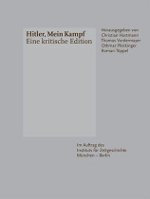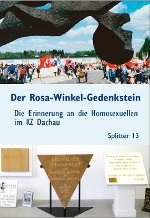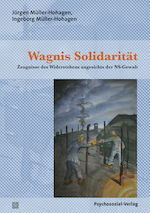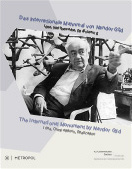Literature tips – Newsletter 7 – 2016
Literature tips
 Garbe, Detlef; Morsch, Günter (eds.):
Garbe, Detlef; Morsch, Günter (eds.):
Kriegsendverbrechen zwischen Untergangschaos und Vernichtungsprogramm. – Berlin:
Metropol 2015 (Konzentrationslager: Studien zur Geschichte des NS-Terrors; no.
1)
The final phase of the “Third Reich” was accompanied
by a scarcely believable increase in terror and violence. There was no
murderous action that the Nazis backed away from, no barbarism or atrocity they
were not afraid to use, no “enemy” who could feel safe. The “total war” they
had declared meant the “total annihilation” of people, countries, cities,
villages. The absolute will of the Nazi regime to exterminate and destroy no
longer had any systematic or economic rationale.
In its first issue, the journal Konzentrationslager. Studien zur Geschichte des NS-Terrors, looks
at the crimes committed as the war was coming to an end. Editors and authors
trace the evidence that indicates how the National Socialists, facing impeding
defeat, now sought to achieve primarily the criminal ideological goals of their
politics of extermination, casting off inhibitions and liberated from pragmatic
military, economic or social considerations as well as sensitivities in the
population.
The journal sees itself as a forum for
researching the Nazi camps, seeking to cover the vast spectrum of themes
involving the camp system and its history after the war, while also stimulating
the historical debate on National Socialism and the mass violence unleashed by
states in the twentieth century.
 Hördler, Stefan: Ordnung und Inferno. Das KZ-System im letzten
Hördler, Stefan: Ordnung und Inferno. Das KZ-System im letzten
Kriegsjahr. – Göttingen: Wallstein 2015
Stefan Hördler calls
into question the predominant view of current research, namely that the
concluding stage of the Nazi concentration camps was characterized by
disorganization, chaos, and random measures: he shows that a comprehensive
reorganization of the concentration camp system was launched in March 1944 and
that the final year of the war represents a distinct stage in the genesis of
the camps. From 1944 onwards the Nazi regime pursued two goals: an accelerated
economization of the camp system and its stabilization. To analysis both
dimensions the author introduces the concept of rationalization, enabling both
the mass murder and the utilitarian-oriented “selection” of prisoners able to
work to be seen as part of this development.
 Institut
Institut
für Zeitgeschichte München – Berlin: Hitler, Mein Kampf. Eine kritische Edition; vol. I und II. –
Munich: Institut für Zeitgeschichte 2016
More than twelve million copies of Adolf Hitler’s
propaganda work Mein Kampf were
printed up to 1945 and distributed throughout the population. It has since then
been prohibited to publish any further editions. Now for the first time, 70
years after Hitler’s death, the Institute for Contemporary History has
published an annotated critical edition of this notorious work.
Mein
Kampf is Hitler’s most important political work. It
is – all at once – a stylized autobiography, ideological program, history of
the Nazi Party, inflammatory propaganda piece, and a guide on how to gain
power, in Germany and beyond. Nowhere else did Hitler explain so openly and in
such detail what he believed and wanted than in this work. Mein Kampf is thus one of the main sources for understanding
National Socialism. The critically annotated edition of the Institute for
Contemporary History is meticulous in its treatment of this source: it arranges
the historical facts, explains the original context, reveals Hitler’s
intellectual precursors, and contrasts his ideas and assertions to the results
of modern research. Not least, the edition shows how Hitler’s ideology
influenced the criminal politics pursued by the Nazi regime from 1933 onwards.
Because Hitler, Mein Kampf. Eine kritische Edition aims at shedding light on the
political and historical myths propagated, its form and style deliberately
addresses a broad reading public.
 Knoll, Albert (ed.): Der Rosa-Winkel-Gedenkstein.
Knoll, Albert (ed.): Der Rosa-Winkel-Gedenkstein.
Die Erinnerung an die Homosexuellen im KZ-Dachau. – Munich: Forum
Homosexualität e.V. 2015 (Splitter; vol. 13)
“Totgeschlagen – Totgeschwiegen” (“bashed up – hushed
up”) reads the inscription on the commemorative plaque for the prisoners forced
to wear the pink triangular patch. In 1985 it was the wish of Munich’s gay
groups to have this plaque of pink marble hung in the Memorial Site’s museum,
as a way of addressing the topic of the persecution of homosexuals at this
location at least. What followed however was a decade-long struggle against old
prejudices, not only amongst the survivors of the concentration camp but also
in political circles. Continuous pressure from the gay scene, backed by a shift
in the zeitgeist, finally brought about change – this victim group was finally
included in commemorations on equal footing with the other groups.
The controversy and discussion about the
long-ostracized victim group of the homosexuals began 30 years ago. To mark the
occasion, the book examines the background to their persecution and follows the
long struggle to gain worthy remembrance.
 Müller-Hohagen, Jürgen; Müller-Hohagen, Ingeborg: Wagnis Solidarität.
Müller-Hohagen, Jürgen; Müller-Hohagen, Ingeborg: Wagnis Solidarität.
Zeugnisse des Widerstehens angesichts der NS-Gewalt. – Gießen:
Psychosozialverlag 2015
In the Nazi era human solidarity was destroyed with
brutal violence. The repercussions reverberate down into the present. Persons
who dared to engage in political resistance against Nazi violence are still
paid far too little attention in the public discourse. Their courage, their
displays of solidarity and their unstinting commitment to ideas of humanity
have only been partially appreciated, their importance as models for the
present and the future yet to be fully acknowledged.
The focus of this book is thus on the testimonies of
former concentration camp prisoners who, motivated by their convictions,
engaged in acts of resistance and solidarity. Ingeborg and Jürgen
Müller-Hohagen look at the long-term and transgenerational consequences of the
destruction of human solidarity. They analyze the process of “forgetting” that
began in 1945 and was very differently accentuated in West and East Germany.
Drawing in part on their own experiences in psychotherapy, counselling, and
schools, they relate this constellation to current day challenges and thus seek
to contribute to a society that is even more strongly defined by solidarity.

Riedle, Andrea; Schretter, Lukas (eds.): Das Internationale Mahnmal von Nandor Glid / The International Monument by Nandor Glid. Idee, Wettbewerbe, Realisierung / Idea, Competitions, Realization; Katalog zur Sonderausstellung / Catalog of the special exhibition. – Berlin: Metropol 2015
The International
Monument is the main place of remembrance in the Dachau Memorial Site. It was
initiated in the 1950s by the Comité International de Dachau (CID), the
association of concentration camp survivors. To realize the project the CID
held two international design competitions in 1959 and 1965, which were won by
the Yugoslav artist Nandor Glid with his concept for a large monument complex
and a central bronze sculpture. The inauguration, overshadowed by student
protests and physical altercations, took place on September 8, 1968.
To mark the seventieth anniversary of liberation
in 2015, the Dachau Memorial Site opened a special exhibition on the background
history and reception of the International Monument. The exhibition and catalog
revolve around important works of art by Nandor Glid, who spent his whole life
exploring resistance and persecution in National Socialism artistically. In
addition, hitherto mainly unknown competition contributions by sculptors and
architects from Britain, France, Germany, Austria, and the former Yugoslavia
are presented. Draft plans and photographs illustrate the design and layout of
the Monument.
